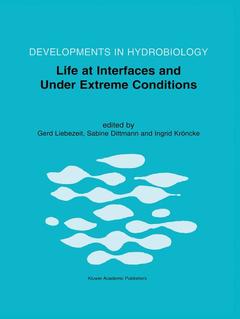Description
Life at Interfaces and Under Extreme Conditions, Reprinted from HYDROBIOLOGIA, 426, 2000
Proceedings of the 33rd European Marine Biology Symposium, held at Wilhelmshaven, Germany, 7–11 September 1998
Developments in Hydrobiology Series, Vol. 151
Coordinators: Liebezeit Gerd, Dittmann Sabine, Kröncke Ingrid
Language: English
Subjects for Life at Interfaces and Under Extreme Conditions:
Keywords
Crustacea; Fauna; Mangrove; algae; development; environment; forest; microcosm; temperature
Life at Interfaces and Under Extreme Conditions
Publication date: 10-2012
210 p. · 19.5x26 cm · Paperback
Publication date: 10-2012
210 p. · 19.5x26 cm · Paperback
Life at interfaces and under extreme condition, proceedings of the 33rd European marine symp. Wilhelmshaven, Germany 7-11 September 1998.
Publication date: 06-2000
210 p. · 21x27.9 cm · Hardback
Publication date: 06-2000
210 p. · 21x27.9 cm · Hardback
Description
/li>Contents
/li>
Interfaces between media, whether air-water or sediment-water interfaces or organisms themselves, pose considerable problems to marine organisms attempting to live at these boundaries.
In the present volume, a number of authors address various aspects of these two topics. Locations under scrutiny range from intertidal areas to the deep sea, while both macro-and meiofaunal organisms are investigated. Distribution patterns and effects of variable temperatures, pressures, and salinities are analysed. Aspects of fouling induction and prevention are also addressed.
This book is intended as a progress report from the 33rd European Marine Biology Symposium held in Wilhelmshaven, Germany, in September 1998.
In the present volume, a number of authors address various aspects of these two topics. Locations under scrutiny range from intertidal areas to the deep sea, while both macro-and meiofaunal organisms are investigated. Distribution patterns and effects of variable temperatures, pressures, and salinities are analysed. Aspects of fouling induction and prevention are also addressed.
This book is intended as a progress report from the 33rd European Marine Biology Symposium held in Wilhelmshaven, Germany, in September 1998.
Organic matter diagenesis at the oxic/anoxic interface in coastal marine sediments, with emphasis on the role of burrowing animals.- Variation in abundances of intertidal populations: consequences of extremities of environment.- The influence of Corophium volutator abundance on resuspension.- Preying at the edge of the sea: the nemertine Tetrastemma melanocephalum and its amphipod prey on high intertidal sandflats.- Meiobenthos of hypersaline tropical mangrove sediment in relation to spring tide inundation.- Spatial and temporal distribution of Myrophis punctatus (Ophichthidae) and associated fish fauna in a northern Brazilian intertidal mangrove forest.- Variability of foraging in highshore habitats: dealing with unpredictability.- Faecal pellet production by Arctic under-ice amphipods — transfer of organic matter through the ice/water interface.- High abundance of Myriochele fragilis Nilsen & Holthe, 1985 (Polychaeta: Oweniidae) in the deep sea of the Eastern Mediterranean.- The vertical distribution of Chthamalus montagui and Chthamalus stellatus (Crustacea, Cirripedia) in two areas of the NW Mediterranean Sea.- First survey of sessile communities on subtidal rocks in an area with hydrothermal vents: Milos Island, Aegean Sea.- Influence of temperature, oxygen and food availability on the migrational activity of bathyal benthic foraminifera: evidence by microcosm experiments.- Main characteristics of the boundary layer macrofauna in the English Channel.- The physiological response of Northern krill (Meganyctiphanes norvegica) to temperature gradients in the Kattegat.- Effects of salinity on larval and early juvenile growth of an extremely euryhaline crab species, Armases miersii (Decapoda: Grapsidae).- Does fluctuating salinity induce branching of Fucusvesiculosus?.- Fungal degradation of the thermoplastic polymer poly-?-hydroxybutyric acid (PHB) under simulated deep sea pressure.- Effect of continuous nutrient enrichment on microalgae colonizing hard substrates.- Relevance of crustacean carapace wettability for fouling.- Decline of the intertidal blue mussel (Mytilus edulis) stock at the coast of Lower Saxony (Wadden Sea) and influence of mussel fishery on the development of young mussel beds.
© 2024 LAVOISIER S.A.S.




